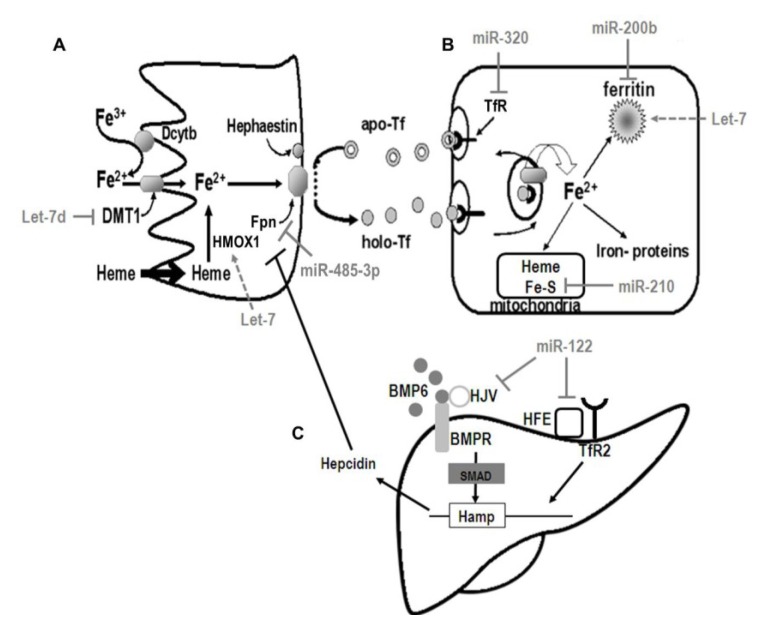Figure 2.
The potential roles for miRNA to influence iron metabolism. (A) Dietary iron absorption. Non-heme (Fe3+) iron may be reduced by duodenal cytochrome B (Dcytb) and transported into the cytosol by divalent metal transporter-1 (Dmt1). Dietary heme iron is transported across the apical membrane by mechanisms that remain unclear and iron is released from heme by heme oxygenase (Hmox1). Hmox1 expression is de-repressed via miR-let-7 targeting the transcriptional repressor Bach1. Iron that is neither stored nor utilized by the enterocyte is exported across the basolateral membrane by ferroportin-1 (Fpn) where it is oxidized by hephaestin before being bound to transferrin for transport to other tissues. Fpn-mediated iron export can be repressed through direct inhibition of Fpn by miR-485-3p. (B) Cellular iron uptake. The transferrin-bound iron binds to the transferrin receptor (TfR) on the plasma membrane. The Tf/TfR complex is internalized through receptor-mediated endocytosis and upon acidification of the endosome iron is released from Tf. The Tf/TfR complex can then be recycled back to the plasma membrane where the complex dissociates at a neutral pH. MiR-320 contributes to the regulation of cellular iron uptake by repressing TfR translation to decrease transferrin-dependent iron uptake. Endosomal iron released from Tf is carried into the cytoplasm by Dmt1, the expression of which may be repressed by miR-let-7d. The iron is then either stored in ferritin or utilized for iron-containing proteins. The regulatory action of miR-let-7 on Bach1 to de-repress ferritin transcription potentially enhances cytosolic iron storage. Utilization of iron is influenced directly by miR-210 which targets the Fe–S cluster assembly proteins Iscu1/2 thereby decreasing mitochondrial metabolism. (C) Systemic control of iron homeostasis. In the liver, Tf interacts with TfR2 and the protein Hfe to trigger the bone morphogenetic protein (BMP) and SMAD signaling cascade via interaction with the BMP co-receptor hemojuvelin (Hjv) to activate Hamp (hepcidin) transcription. The liver specific miR-122 directly targets HFE and HJV to contribute to the regulation of systemic iron homeostasis by decreasing hepcidin mRNA expression.

